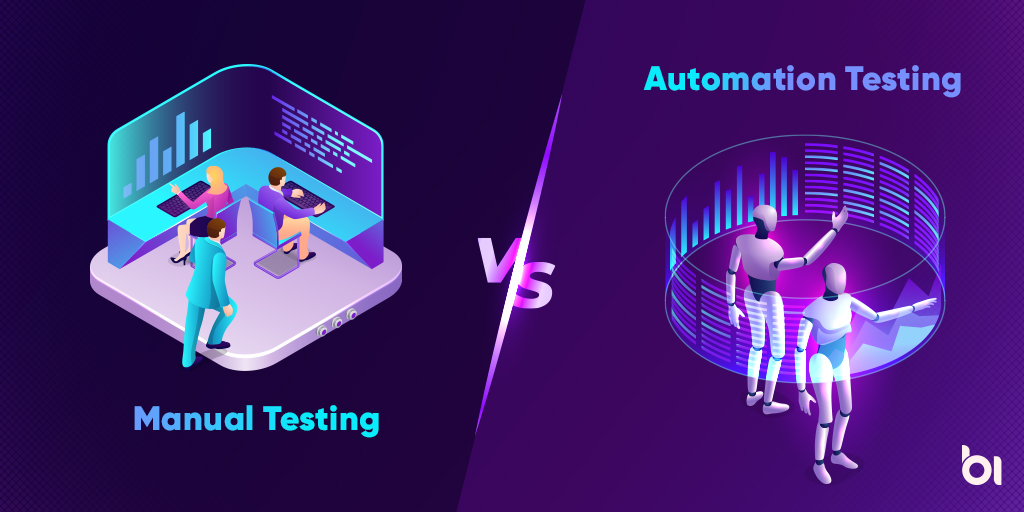At first, testing was done manually, however in this day and age everybody needs a simple life and why not testers? With this idea, Automation Testing came into the image and things changed definitely.
Let’s see, The difference between Manual Testing vs Automation Testing? To make life a little easier, let’s break these two terms down.
Table of Contents
ToggleManual Testing
It’s when you get hands-on and have to test the code as it’s being developed. It’s a tedious process that can take anywhere from a few weeks to many months for each release. You can test thousands or even millions of different scenarios across hundreds of individual endpoints, but it’s up to you to create each of these scenarios in a way that satisfies you.
Automation Testing
It’s when the automated testing is setup to ensure that the system is working the way it’s supposed to. It’s so much easier and faster because it doesn’t need you to modify the code to create each scenario. In addition, you won’t have to worry about old workstations and can focus on getting new workstations configured and tested.
Automated testing can be done on a cloud platform, but sometimes it’s easier to do it on your own. Make sure you’re using the right tools and setting up the right workstation settings. If you’re not doing it yourself, you’re doing it wrong.
Types of tests
There are many different types of testing to use for both manual and automated testing. Let’s look at the different types and why you would or wouldn’t choose them.
Static testing
Static testing is performed on the existing code. Static tests are typically dynamic (i.e., they’re executed on a program’s execution path). Most often, you’ll find static tests when you’re testing an automated testing solution. Static tests allow the developer to see how the app’s functionality is working without changing the code.
To do this, you can use the same scripts to test each instance of an endpoint. The scripts could be invoked from within the IDE for automating the testing. This ensures that the tests are run the same way each time, which is especially helpful if you’re using automated testing.
For example, if you’re writing tests to test your React components, you could use this as a testing method to write a test that will render a full application.
Execution-based testing
Execution-based tests are dynamic. While they don’t get executed, they’re just as important. To perform execution-based tests, you’ll need to create separate scripts to test each endpoint. As an example, the test would look like this:
User.connect();
User.getUser(id);
User.saveUser();
In this test, we’re not executing the test script but are instead invoking each of these methods and checking to see if the test is executed.
For our purposes, execution-based testing can be a good way to add test coverage to an existing project.
The downside to execution-based testing is that, while you’re testing, the app isn’t being updated. The tests might be updated as they’re being performed, but you still need to be aware of that. It can be a tedious task to keep all of your endpoints in an active state.
In addition, execution-based tests need more setup and can be more difficult to maintain. If you don’t want to write more scripts to run, the other option is to manually test each endpoint. However, if you’re dealing with large amounts of endpoints, executing each endpoint manually is often a slow and time-consuming process.
Unit testing
Unit testing is a form of automated testing where you create one script to test the functionality of a specific piece of functionality (an endpoint).
In this case, we’re testing the functionality of the User component of the application. To create the script, we’ll use the Sinon framework. This makes testing easier by adding a lot of functionality to your tests and provides a JavaScript framework to use to make your tests more testable.
When you run your tests, you’ll need to provide Sinon with the correct instance of the correct endpoint as well as the correct validators that will test the behavior of each endpoint. You can then test the endpoint by using the script to perform the necessary actions, or you can even load the URL in another script and use that script’s functions to test it.
For example, to test the GetUser method:
$sinon.sandbox.load(“https://graph.facebook.com/…”)
This will test whether the GetUser method was called by Facebook or by any other controller in your application.
Read More: Emerging Automation Testing Trends in 2020
Here’s a quick comparison of Manual Testing vs Automation Testing
Manual Testing vs Automation Testing. Confused?
Automation testing is the way to go if you want to make sure your software is ready for production. It’s a holistic approach to testing. It’s also cost-effective, since you’re not always testing for every possible scenario. If you automate, you don’t have to constantly validate your tests against each individual action that a user might perform.
For example, one of our customers automates their metrics generation, so they don’t have to use their own console every time they want to perform a test. The only time this is necessary is when you want to exercise a metric based on a user action.
However, automation isn’t a silver bullet. You need to keep manual testing in mind at all times, no matter what testing framework you’re using.
If you’re planning to move away from automated testing, a good place to start is with tools that will help you perform manual testing, like tFire, Dot Test 2 and Checkstyle.
Manual is still the best way to improve test coverage
The difference between automated testing and manual testing is the same as the difference between working by yourself and working with a team.
Even though you’ll never be able to develop a perfect software test that will catch every possible problem before you release, if you’re working with other developers, you can reduce the amount of work you need to do.
There are still a few manual testing tools that support automation, but if you’re not willing to get familiar with their implementation details, they won’t do you much good. You’ll still need to write your tests in a meaningful way, and then validate them manually.
For example, if you’re using tFire, it will actually try to generate automated tests for your code—but you can still skip these tests and proceed with testing manually. Likewise, if you’re using Checkstyle, you can still generate automated tests—but in the event that you’re comfortable with automation, you can also skip these and proceed with manual testing.
Automation Testing Services Company
Don’t neglect manual testing
Automation isn’t a panacea. If you don’t perform manual testing and rely only on automated testing, you might find that your tests can’t keep up with the business. But if you’re willing to invest the time, you can make your software testable without having to hire more developers to test your code.
Manual Testing vs Automation Testing: What to Choose
Let’s face it: to succeed in delivering high-quality applications, you need to test your code. Testable code can deliver on everything you’ve asked for, leading to an infinite stream of happy customers. Not all developers are willing to spend time on manual testing of their code (just as not all developers are willing to spend time with UI testing, either). So, what are the alternatives?
First, let’s make sure we’re all on the same page. An automated test (often referred to as a test automation framework) is a program that “runs” your tests by running them in a virtual environment. These can be run manually or automatically (e.g., via continuous integration systems), and can easily simulate or mimic some of the most common scenarios your application may encounter.
And here’s the kicker: manual testing is now considered a “best practice” in the software industry. Although it can be complex, it doesn’t have to be difficult. Even if you don’t have a strong background in testing or design, there are several websites that provide ready-to-go examples of how to write tests:
Unfortunately, the industry is not yet there yet, as to my knowledge, there is still a significant distinction between testing and testing automation, and many developers continue to work in silos without cross-functional testing. Until this changes, automation is likely to be at the leading edge of our industry for the foreseeable future.
Bottom Line
Testing should be an integral part of software development. There are many factors you should take into account when choosing your testing strategy (Manual Testing vs Automation Testing). The ground rule for testing: try to implement as much automated testing as you can.
Manual testing is slow and doesn’t fit into today’s agile practices. The benefits of automated testing are far greater than those of manual testing. That’s why your company should invest in setting up an automated testing suite. Take a look at our guide to help you get started. Good luck!




